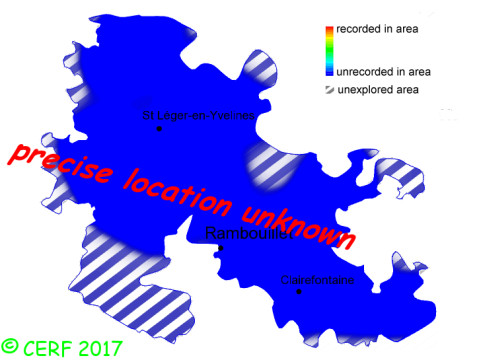|
Strobilomyces strobilaceus (Scop.:Fr.) Berk.
|
common name(s) : Old Man Of The Woods, Old Man of the Woods
New classification: Basidiomycota/Agaricomycotina/Agaricomycetes/Agaricomycetidae/Boletales/Boletaceae
Former classification: Basidiomycota/Homobasidiomycetes/Agaricomycetideae/Boletales/Strobilomycetaceae
synonyms: Strobilomyces floccopus, Boletus floccopus, Boletus strobilaceus
(unconfirmed synonyms: Strobilomyces strobiliformis)
edibility : discard
|
|
|
The cap is blackish brown (mouse grey when young) to blackish grey or brown (dark scales on a pale background), fleshy to tough, hemispherical then convex for a long time and ultimately expanding.
The cap surface is dry and covered with soft, woolly dark brown scales, shaped like imbricated, more or less erect pyramids.
The cap margin is thick, inrolled and exceeding.
The stem is white at the top, covered further down with large brown shaggy scales concolorous to cap, sheathing the stem up and ending to form a ring. It is long, cylindrical, full, tough and fibrous. The ring is white above, short-lived and sometimes missing, woolly, stained with brown and with velar remnants..
The flesh is quite thick, soft to spongy then tough (woody in the stem), brittle in the stem base like charcoal. It is pale grey, becoming pink then black when exposed to air; its taste is generally not distinctive, or nutty, or mild ; the odour is varying; according to authors: unpleasant, earthy, fruity, strong hard to define;
The tubes are adnate to slightly decurrent, moderately long (11-17mm). They are white to olive grey, reddening then blackening when cut.
The pores are large, more or less round, rather angular/polygonal, grey then blackish brown, turning red then black when pressed.
The spore print is purple-black.
It grows in broad-leaved or coniferous forests, often in recently disturbed soil or with molehills. It is rare on sandy ground, and comes usually solitary or sometimes in small troops, on a rather acid and rich soil, with beech, hornbeam, spruce, pine, fir.
The fruiting period takes place from July to November.
| Dimensions: | width of cap approximately 10 cm (between 4 and 20 cm) |
| | height of stem approximately 11 cm (between 5 and 17 cm) |
| | thickness of stem (at largest section) approximately 20 mm (between 10 and 30 mm) |
| | spores : 10-11 x 9-10 microns, subglobulose to egg-shaped |
Distinctive features : cap and stem covered with large brown shaggy wart-like scales; greyish pores turning eventually red-brown, turning red when pressed; pallid and flaccid flesh, turning red then black when exposed to air
Strobilomyces strobilaceus is rare and confined in the forest of Rambouillet, and is quite rare, more generally speaking
.
|  | | Above : distribution map of Strobilomyces strobilaceus in the forest of Rambouillet |
|
page updated on 14/01/18
